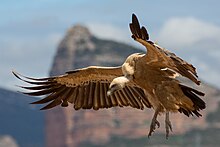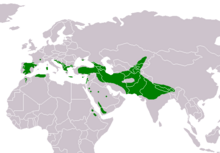Loading AI tools
Species of bird From Wikipedia, the free encyclopedia
The Eurasian griffon vulture (Gyps fulvus) is a large Old World vulture in the bird of prey family Accipitridae. It is also known as the griffon vulture,[4] although this term is sometimes used for the genus as a whole. It is not to be confused with the Rüppell's vulture (Gyps rueppellii) and Himalayan vulture (Gyps himalayensis). It is closely related to the white-backed vulture (Gyps africanus).
| Eurasian griffon vulture | |
|---|---|
 | |
| Flying griffon vulture photographed in Spain | |
| Scientific classification | |
| Domain: | Eukaryota |
| Kingdom: | Animalia |
| Phylum: | Chordata |
| Class: | Aves |
| Order: | Accipitriformes |
| Family: | Accipitridae |
| Genus: | Gyps |
| Species: | G. fulvus |
| Binomial name | |
| Gyps fulvus | |
| Subspecies[3] | |
| |
 | |
| Range of griffon vulture | |
| Synonyms | |
|
Vultur fulvus | |
The griffon vulture is 93–122 cm (37–48 in) long with a 2.3–2.8 m (7 ft 7 in – 9 ft 2 in) wingspan. In the nominate race the males weigh 6.2 to 10.5 kg (14 to 23 lb) and females typically weigh 6.5 to 10.5 kg (14 to 23 lb), while in the Indian subspecies (G. f. fulvescens), the vultures average 7.1 kg (16 lb). Extreme adult weights have been reported from 4.5 to 15 kg (9.9 to 33.1 lb), the latter likely a weight attained in captivity.[5][6] Hatched naked, it is a typical Old World vulture in appearance, with a white head, broad wings and short tail feathers. It has a white neck ruff and yellow bill. The buff body and wing coverts contrast with the dark flight feathers.
This section needs additional citations for verification. (November 2022) |

In Italy, the Eurasian griffon vulture has survived only in the island of Sardinia, but there have been recent attempts to reintroduce it in the peninsula. As a result, several specimens were spotted in August 2006 on the Gran Sasso massif in central Italy. Populations in Italy are thought to be increasing thanks to reintroduction schemes in neighbouring countries and a ban on hunting it.
In Croatia, a Eurasian griffon vulture colony lives near the town of Beli on the island of Cres.[7] There they breed at low elevations, with some nests at 10 m (33 ft). Therefore, contact with people is common. The population makes frequent incursions in the Slovenian territory, especially in the mountain Stol above Kobarid. The bird is protected in an area called Kuntrep on the Croatian island of Krk.[8] In Ireland, the first record of a griffon vulture occurred in 1843 in Cork.[9] In 2000, a vulture took up residence on the Channel Island of Guernsey.[10]

In Cyprus, there was a colony of fewer than 30 Eurasian griffon vultures at Episkopi, in the south of the island in 2006.[11]

In Israel, Eurasian griffon vulture colonies are present in the north and the Golan Heights. A large colony breeds in the Carmel Mountains, the Negev desert and especially at Gamla. Reintroduction projects are being carried out at breeding centres in Carmel Hai-Bar Nature Reserve and Yotvata Hai-Bar Nature Reserve.
In Greece, there are nearly 1000 Eurasian griffon vultures. The majority of this population resides in Crete, which hosts the largest insular population of the species in the world.[12] On Crete they inhabit mountainous areas, sometimes in groups of up to 20.[13]

Griffon vultures have been reintroduced successfully into the Massif Central in France; about 500 are now found there. Griffon vultures are regularly spotted over the Millau bridge, and since 2015 also in the Cantal Mountains.
In Serbia, there are around 60–65 pairs of Eurasian griffon vultures in the western parts of the country, around Zlatar mountain and also 35 birds in the canyon of the Trešnjica river.[19] They are under legal protection from hunting.[20]

In Austria, there is a remnant population around Salzburg Zoo, and vagrants from the Balkans are often seen.In Spain and France, in 2008, there were 25,000 birds, from a low of a few thousand around 1980. Spain has the biggest colony of Griffon vultures in all Europe. It is located at Hoces del Río Duratón Natural Park.

In Portugal a few hundred pairs of griffons nest, but their distribution is strongly asymmetric. The main areas of reproduction are located in Douro International Natural Park, which is home to more than half of the Portuguese population. Though permanently resident in the interior of the country, the griffon vulture often ventures west when the breeding season is over and can occasionally reach the Tagus Estuary and Cape St. Vincent.[21] The Pyrenees population has apparently been affected by an European Commission ruling that due to danger of bovine spongiform encephalopathy transmission, no carcasses must be left on the fields for the time being. This has critically lowered food availability, and consequently, carrying capacity. Although the griffon vulture does not normally attack larger living prey, there are reports of Spanish griffon vultures killing weak, young or unhealthy living animals when they do not find enough carrion .[22] In May 2013, a 52-year-old woman who was hiking in the Pyrenees died after falling off a cliff. Eurasian griffon vultures devoured her corpse before rescue workers arrived and found only her clothes and a few bones.The story attracted attention to griffon vulture problems in Southern Europe.[23]
In Armenia there are 46-54 pairs according to last estimation of population; the trend demonstrates slight increasing.[24] In Russia, nests on the northern slopes of the Greater Caucasus.

Like other vultures, it is a scavenger, feeding mostly from carcasses of dead animals which it finds by soaring over open areas, often moving in flocks. It grunts and hisses at roosts or when feeding on carrion.
The maximum recorded lifespan of the griffon vulture is 41.4 years for an individual in captivity.[25]
It breeds on crags in mountains in southern Europe, north Africa, and Asia, laying one egg. Griffon vultures may form loose colonies. The population is mostly resident. Density Dependence in this colonial species has been shown to affect annual reproductive success with eyries in protected location (caves, potholes and sheltered ledges) producing more fledglings, and used preferentially, than low-quality eyries (exposed ledges and open crevices), which were only used when the number of breeding individuals increased.[26]

Griffon vultures have been used as model organisms for the study of soaring and thermoregulation. The energy costs of level flight tend to be high, prompting alternatives to flapping in larger birds. Vultures in particular utilize more efficient flying methods such as soaring. Compared to other birds, which elevate their metabolic rate to upwards of 16 times their basal metabolic rate in flight,[27] soaring griffon vultures expend about 1.43 times their basal metabolic rate in flight. Griffon vultures are also efficient flyers in their ability to return to a resting heart rate after flight within ten minutes.[28]
As large scavengers, griffon vultures have not been observed to seek shelter for thermoregulation. Vultures use their bald heads as a means to thermoregulate in both extreme cold and hot temperatures. Changes in posture can increase bare skin exposure from 7% to 32%. This change allows for the more than doubling of convective heat loss in still air.[29] Griffon vultures have also been found to tolerate increased body temperatures as a response to high ambient temperatures. By allowing their internal body temperature to change independently of their metabolic rate, griffon vultures minimize their loss of water and energy in thermoregulating.[30] One study in particular (Bahat 1995) found that these adaptations have allowed the Griffon vulture to have one of the widest thermal neutral zones of any bird.[31]
Griffon vultures have shown no age difference in their feeding rates. Feeding rates do tend to increase when more food is available. Studies connected with reintroduction of the vultures have found that older adults are more inclined to display aggressive behaviour and signs of dominance. The sexes have shown no difference in competitive behaviours. Reintroduced and wild-bred birds did not differ in dominance or feeding rate despite their differences in upbringing.[32]
The main cause of the rapid decline in the griffon vulture population is the consumption of poisoned baits set out by people. Wildlife conservation efforts have attempted to increase awareness of the lethal consequences of using illegally poisoned baits through education about the issue.[33]
Seamless Wikipedia browsing. On steroids.
Every time you click a link to Wikipedia, Wiktionary or Wikiquote in your browser's search results, it will show the modern Wikiwand interface.
Wikiwand extension is a five stars, simple, with minimum permission required to keep your browsing private, safe and transparent.